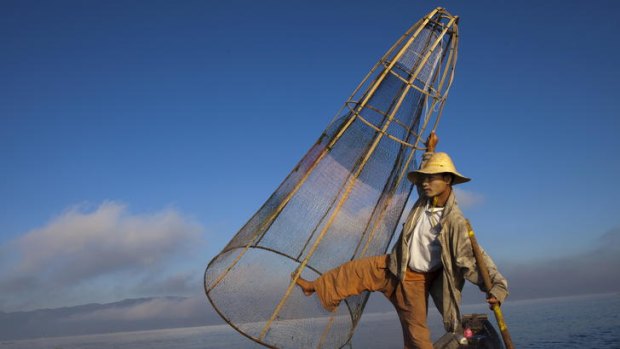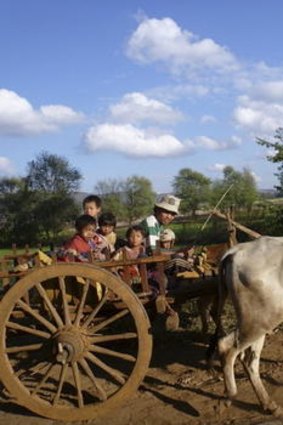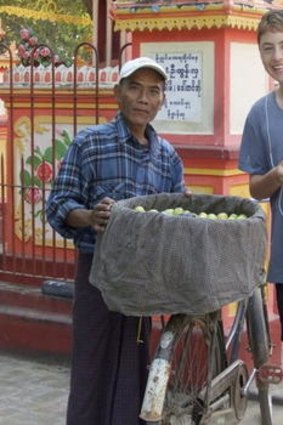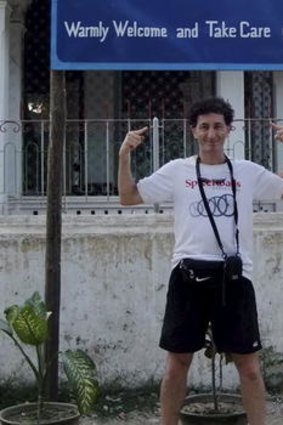
Fishing on Inle Lake.Credit: Getty Images
What happens when two families, including four internet-addicted teenagers, take to the back roads of Burma on a challenging two-week trip on two wheels? As Stephen Sheldon finds, the bumps aren't just in the roads.
THE Burmese people say that if you give out friendliness, then friendliness will be returned to you. And they practise what they preach, which makes this mostly Buddhist country one of the most hospitable and welcoming on the planet.
Cycling down the back roads, schoolchildren come tearing out of the yards and bamboo and thatch cottages to high-five us. Adults wave from the roadside, calling the all-pervasive greeting of "Mingalabar" (Hello).
Even hot and sweaty road workers stop for a moment to wave and smile. The feeling of goodwill is infectious and we wave, high-five and shout "Mingalabar" wherever we go.
This friendliness, and the lack of traffic, makes Burma a joy for cyclists. The one drawback is the narrow roads, which are usually stony, potholed, bone-jarring bum-busters.
Many cycling enthusiasts say your backside adjusts after a few days but even our smiling SpiceRoads cycling guides, Myo and Aung, confide early on that their derrieres are permanently sore. So, no chance for us part-time riders.

A Burmese family passes by.Credit: Stephen Sheldon
Thankfully, we are able to put our discomforts aside as we take in the country's sights.
We pass thatched bamboo stalls selling watermelons, oranges and peanuts. We slog past fields of sunflowers, sugar cane and tobacco. We whoosh past monasteries, temples and shrines. We see women making incense by hand, cooking over braziers and washing in rivers.
Along the way we dodge dogs, goats, buffalo, monkeys and even snakes. There are very few cars in the countryside. The traffic is mainly buffalo carts, trishaws, cyclists and heavily laden farm trucks, which we easily glide past on our 24-gear mountain bikes.

East meets west at Thanbodday temple.Credit: Stephen Sheldon
We soon learn to distinguish the horns of the different vehicles coming up behind us, from the short beep-beep of passing motorbikes to the loud, Sydney ferry-like honk of large trucks and buses.
In the first few days, our teenagers suffer internet-withdrawal symptoms - the internet is almost non-existent outside the larger cities such as Yangon and Mandalay. They also endure sore bums and tired legs. Inexperienced in Third World travel, they find it difficult to get used to the heady smell of diesel, sewage, wood smoke and rotting garbage.
But as we travel, there is a dawning appreciation of this amazing country, with its warm and industrious people and unusual cuisine, which combines Indian, Thai and Chinese. (Burma shares its squiggly borders with these countries as well as with Laos and Bangladesh.)

A welcome sign at Mingun.Credit: Stephen Sheldon
The lack of Western references is also fascinating. This is a country most of the big global brands have yet to penetrate.
About the only negative is sickness. On day two, a nasty tummy bug forces the other dad, Colin, to hurriedly leave the dinner table. Unfortunately, the bug remains on our tour, working its way through each member of the group.
Our journey begins at the Popa Mountain Resort, which is perched on the side of an extinct volcano. The volcanic soil makes Mount Popa a verdant oasis in what is otherwise a harsh, dry landscape.
The resort looks across to the equally stunning Popa Taung Kalat, a sheer-sided volcanic plug topped by a Buddhist monastery. Getting there involves a sweaty climb up 777 steps and fending off macaque monkeys.
The resort is worth the trip alone - a series of teak cottages strung out like jewellery boxes, linked by lantern-lit boardwalks that traverse the jungle. I could have happily stayed there, enjoying the views from my verandah or the wet-edge pool.
But you know how trips are. Just as you're settling in, it's time to move on. Early next day, we cycle down the mountain and 50 kilometres across the plains to the ancient city of Bagan.
Bagan is a must-see for any visitor to Burma - a sprawling landscape dotted with more than 2200 sandstone-coloured temples and shrines beside the Irrawaddy River that appear like inverted cones of gelato in the scrubby, red-dirt landscape. They were built between the 11th century and 13th century by the kings of Bagan.
We walked and cycled around the temples. Also worth doing, I'm reliably told, is the hot-air balloon ride at dawn. But dawn and teenagers are not easy bedfellows, so we give it a miss.
Our visit to Bagan coincides with the month-long festival commemorating the Ananda Pagoda, regarded as the most beautiful temple in Bagan. By chance we happen to bump into the busiest day of the festival - full-moon day - when pilgrims arrive for the consecration of the temple and a knees-up at the adjacent fair.
The highlight is a human-powered Ferris wheel that would not pass muster with Australian safety regulations. The wheel is powered by six boys who climb to the top and use their weight to get it rotating. Even our teenagers think it's pretty cool.
After two days, we head to the river, where a rickety boat takes us down the Irrawaddy to the sleepy market town of Pakokku. On the way, we watch farmers laboriously hand-water peanut crops on the flood plain as we dreamily putt-putt past, crunching on tamarind sweets and taking turns on Colin's travel guitar.
From Pakokku we cycle through the Chindwin Valley to another of the highlights of our trip - the hillside of Po Win Taung. The place is right out of Raiders of the Lost Ark, a wonderland of overgrown caves adorned by thousands of murals and Buddhist carvings, complete with hordes of inquisitive monkeys. It's worth the dusty 60-kilometre return ride.
The next day, we head to the Hindu-style Thanbodday temple complex, south-east of Monywa, on the eastern bank of Chindwin River. Thanbodday is one of Burma's biggest attractions. Yet, like almost all sites outside Yangon or Mandalay, when we visit it is almost devoid of tourists.
The site dates to 1303 and features hundreds of gleaming gold-topped stupas. Inside, there are more than 500,000 Buddha images of all sizes, including some wacky ones with psychedelic lights radiating from the Buddha's head.
The abundance of Buddhas is starting to get to the younger set, who are starting to chant a mantra of "No more temples". And it's hard to blame them.
Then it's off to Mandalay, Burma's second-largest city, where we stay at the Mandalay Hill Resort, with its funky colour-changing pool.
Joy of joys, there's also free wi-fi in the lobby. We leave the teenagers behind to hit Facebook and scoff overpriced hamburgers while the adults explore the towns of Sagaing and Mingun on the opposite side of the Irrawaddy.
We start our day with a leisurely stroll across the beautiful U-Bein Bridge, the longest teak bridge in the world, which spans the serene Taungthaman Lake. Then we follow our guides for a hair-raising ride through city traffic before an afternoon coasting beside the river.
This is an exquisite ride, highlighted by a visit to the ruins of the massive Pahtodawgyi stupa and the Mingun bell, the largest ringing bell in the world.
After a couple of days in Mandalay, we load the bikes on the truck, hop into our vans and head north to the Shan plateau, where it's a chilly 10 degrees and our guides take to wearing beanies under their bike helmets. Starting at Ywar Ngan, we ride the unrelentingly stony and narrow road through a patchwork of crop lands to the sleepy township of Pindaya, which nestles in a picture-postcard valley beside Botoloke Lake.
Pindaya's claim to fame is its limestone caves, which house thousands of Buddha images dating from the 11th century. There are rows of tourist buses, a glass lift to take visitors to the caves and an awful lot of gold leaf.
For us it's all a bit gaudy and, instead, the highlight of our stay is a trek into the mountains for lunch at a local village. After days of riding, my muscles are a touch reluctant but the splendid views of tea plantations and wheat fields ensure the trip is worthwhile.
After two days, we're back in the saddle and off to the former British colonial hill station of Kalaw. The traffic is light as we wind our way uphill and, just as our legs begin to tire, we are greeted by a sweeping descent that takes us all the way into town.
We love Kalaw. Like so many other places on our trip, we could have stayed here for several days, poking about in the markets, dallying in the pastel-painted Indian tea houses and enjoying the Nepalese cuisine.
But we are coming to the end of our journey and it's time to move on. Happily, the guides have left the best until last - the ride to the famed Inle Lake.
After comfortably traversing the Heho plains, we are pleasantly surprised to hit what must be Burma's smoothest road and discover we have an uninterrupted 10-kilometre descent.
As we sweep around the mountains, the easy pedalling seems just reward for uphill slogs. The teenagers are in heaven, riding hands-free for much of the descent, but my fingers are never far from the brakes.
Inle Lake could be described as the Venice of Asia. Its star attractions are the fishermen who cleverly row their gondolas with one leg wrapped around the oar while they peer below the reed-covered surface to look for fish below.
We spend the first day cycling out of town along narrow roads that snake through cane fields, with the pungent smell from sugar mills heavy in the air.
The next day we glide around the lake on a gondola. There's plenty to see - the fisherfolk, temples, floating vegetable gardens and the Nga Phe Chaung monastery, with its trained jumping cats - and our cameras work overtime.
On our final night, we look back on the trip, reflecting on how far we have travelled and how much we have managed to see and experience. We are adamant that we'll be back before First World development makes too many inroads here. But I'm not sure the teenagers will join us.
Trip notes
Getting there
Thai Airways flies from Sydney to Bangkok with connections to Yangon, thaiairways.com.au.
Staying there
Popa Mountain Resort. Prices range from $100 (deluxe) to $200 (superior). rsvpopa@myanmar .com.mm.
Mandalay Hill Resort Hotel. From $120 for a superior room to
$1200 for a Mandalar suite. mandalayhillresorthotel.com.
When to go
Between November and February, when it is cooler and drier.
What to buy
There's plenty to splash out on. You'll find beautiful sarongs (or longyi), woven shoulder bags, lacquerware, buffalo-horn salad servers and furniture and household implements.
What to take
Bring a full medical kit, with medicines to combat nausea and diarrhoea, toe cages for your bike and chocolate if you can't survive without it (the local stuff is scarce and disappointing).
Join a group or go it alone?
There are a few cycling tour companies, such as SpiceRoads, that will provide a guided trip, including accommodation, food and bike hire. The trip referred to in this article is SpiceRoads' Burma Adventure, which costs $US2895 ($2721) for 14 days.
We are fairly picky travellers but couldn't fault the organisation or the level of support offered, which included airconditioned vans, a truck for the bikes and English-speaking local guides.
If you want to go it alone, you'll need some mechanical know-how and will have to find accommodation in far-flung places where comfortable digs may be scarce. Also, almost no signs are in English and few people in rural areas speak English.
Money, money, money
Changing money in Burma is unlike any other country. For a start, you can only use pristine US dollars. Also, many banks don't provide foreign-currency exchange, which has led to a thriving black market. And to top it off, credit card facilities are almost non-existent.
So you need to estimate how much money you'll need and bring it in crisp, new US dollars. Anything less will earn you a snub at the black-market exchange or a reduced rate. Also, higher-denomination US notes attract a better exchange rate than lower denominations (don't ask why).
Sign up for the Traveller Deals newsletter
Get exclusive travel deals delivered straight to your inbox. Sign up now.